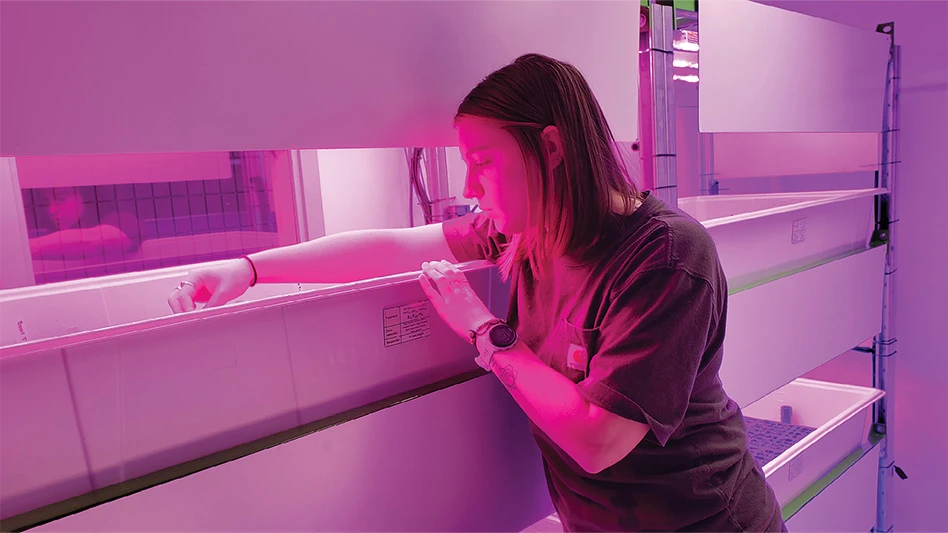|
.jpg) The horticulture industry is faced with both quantity and quality challenges when it comes to water. The technologies are readily available to address water quality issues. The quality challenge is reduced to an economic evaluation to determine the appropriate treatments to satisfy growers' crops. The horticulture industry is faced with both quantity and quality challenges when it comes to water. The technologies are readily available to address water quality issues. The quality challenge is reduced to an economic evaluation to determine the appropriate treatments to satisfy growers' crops.
The water quantity or availability challenge lies in the fact that the fresh water available for human consumption is finite and not evenly distributed. Predicted climate changes are expected to exacerbate water shortages in the world's water scarce regions. Low water availability and droughts will have severe consequences on many sectors, particularly on irrigated agriculture and hydropower generation with its demand for cooling water.
Where one lives or operates a growing operation can have a large impact on current and future costs of doing business. The use of shading can have a significant impact on the quantity of water needed to produce ornamental plants and vegetables.
The water quantity challenge
There is plenty of water on Earth. The problem is that most of it is either too salty or it is frozen. According to the "Encyclopedia of Climate and Weather," of all the Earth's water, only 3 percent is fresh and 70 percent of that water is in icecaps and glaciers.
Water is distributed by weather, which is always changing. Water is never evenly distributed over large regions. Growers do not always live and work in areas where water is regularly plentiful for irrigation.
Looking at a recent drought stress map from the U.S. Drought Monitor shows areas of the country experiencing various levels of drought. Parts of the country, particularly those throughout much of the southern regions are under exceptional drought. This protracted period of deficient precipitation has resulted in extensive damage to crops and loss in yields.
 Water is not evenly distributed and many regions in the southern states are regularly in drought conditions. Water is not evenly distributed and many regions in the southern states are regularly in drought conditions.
The solutions to water quantity challenges are obviously to use water where it is available and to use less. Growers can use less water by incorporating technology that informs them when and how much water is necessary and by delivering the water where it is needed with as little waste as possible.
Determining water needs
Research is being conducted to determine how much water ornamental plants really need (See water sensors article on Page 56). Many ornamental plant growers tend to overwater their plants. Future watering of ornamental plants will be controlled by carefully placed sensors that monitor substrate moisture, temperature and humidity. The sensors will trigger the initiation and duration of an irrigation event.
Evaporation and transpiration
Evaporation describes how free surface water returns to the atmosphere. Evaporation is largely dictated by net radiation. Transpiration is essentially leaf surface evaporation, but more specifically it is the part of the water cycle where water is gained by the roots and water vapor is lost from stomatal openings in leaves, stems and flowers. Transpiration cools the plants as well as enables the flow of mineral nutrients from the roots to the shoots.
These terms together, called evapotranspiration, explain where water goes in the greenhouse and nursery environments. Transpiration is mainly affected by the radiation exchange between the plant canopy and the environment and air vapor pressure deficit inside the greenhouse. Vapor pressure deficit is the difference between the vapor pressure at saturation and the effective vapor pressure.
Water-use efficiency and shading
Almeria, Spain, is on the Mediterranean Sea and is on the same latitude as Norfolk, Va., Tulsa, Okla., and Salinas, Calif. It is an area of significant vegetable production under plastic cover. Growers there are challenged with a large evapotranspiration demand and salt water intrusions that increase the salinity of fresh irrigation water. Efforts to find solutions to the water quality and quantity problems have included evaluating the use of mobile shading on greenhouses and the impact on tomato and cucumber yields.
Yield reductions due to decreased photosynthesis associated with fixed shading were known from earlier studies. It was suspected that reductions in the greenhouse temperature and evaporative demand during periods of high radiation through the use of mobile shading could produce quality and water efficiency benefits that would offset any decrease in photosynthetic potential.
Using OLS50 Abri, an exterior, reflective shade with 50 percent light transmission, as mobile shading, improved the quality of tomatoes. The shading helped to reduce the occurrence of blossom end rot and increased the marketable yield of cucumbers. The shade also reduced crop transpiration and water uptake.
The incident radiation integral under the shade was reduced by 36.5 and 22.4 percent in the tomato and cucumber crops, respectively. The shading decreased the maximum temperatures by about 6°F and 5°F in the tomato and cucumber crops, respectively. The water use efficiency was increased by 47 percent and 62 percent for the tomato and cucumber crops, respectively. Water use efficiency (gram of produce per liter of water used) was derived as a ratio of the yield (kilograms of fruit over the greenhouse area) and water uptake (liters of water irrigated over the greenhouse area). The same or better crop results with half or less water input is compelling and should translate to ornamental crop production as well.
Selective shading is a valuable cooling method in climates with high evaporative demand, and particularly in those areas where water is a scarce resource. To evaluate this phenomenon within your own operation, compare this on a plant unit basis to areas where you may not be using selective shading. The first step to applying less water is to measure where it is being used and to go for the easy reductions.
 A mobile shading installation of OLS Abri, an exterior, reflective shade with 50 percent light transmission. A mobile shading installation of OLS Abri, an exterior, reflective shade with 50 percent light transmission. |
Reflective materials
North Carolina State University agricultural engineer Dan Willits began working with shade fabrics in the South in the late 1980s. His research addressed complaints by growers of the inability to properly cool greenhouses to produce acceptable levels of marketable crops during the summer. Initially he found that black cloths were ineffective at lower shade levels and only about 50 percent effective at reducing greenhouse temperatures with corresponding shade levels at higher shading levels. Early tests with white shade cloth showed efficiency improvements. Further research represented attempts to improve shade cloth efficiency by reducing shade cloth temperature.
Willits demonstrated dramatic improvements in shading efficiency. This was related to cooling the greenhouses while reducing useful light by lowering shade cloth temperature by sprinkling with water or by other means. More recently, he continued the research with reflective, white and aluminum exterior shade cloths that had a lower effective temperature, which was driving absorbed heat into the greenhouse.
Willits found that by replacing a 60 percent black knitted shade with a reflective shade cloth reduced the mean air temperature by 24 percent and the enthalpy or energy gain by 35 percent. For a situation with no plants, air temperature rise is directly related to the energy gain. With plants, total energy gain must take into account the latent energy of plant transpiration. The consequence of reducing energy gain more than temperature rise is lower leaf temperatures. This also means that less water is being consumed via evaporation and transpiration in the greenhouse.
Temperature is an indicator of the climate quality for crop and worker comfort. However, it is commonly estimated that half of the heat entering the greenhouse is raising the temperature (an indicator of sensible heat), and the other half is attributed to evaporating water (latent heat), from free water surfaces and leaves. Irrigation events, especially if performed by hand, are reduced when shading is deployed. Provided that the daily light integral is satisfactory to produce a quality crop, shading during hours of high radiation offers both cooling and water savings.
Kurt Parbst is president, Ludvig Svensson Inc., (704) 357-0460; www.ludvigsvensson.com.
|

.jpg) The horticulture industry is faced with both quantity and quality challenges when it comes to water. The technologies are readily available to address water quality issues. The quality challenge is reduced to an economic evaluation to determine the appropriate treatments to satisfy growers' crops.
The horticulture industry is faced with both quantity and quality challenges when it comes to water. The technologies are readily available to address water quality issues. The quality challenge is reduced to an economic evaluation to determine the appropriate treatments to satisfy growers' crops. 








